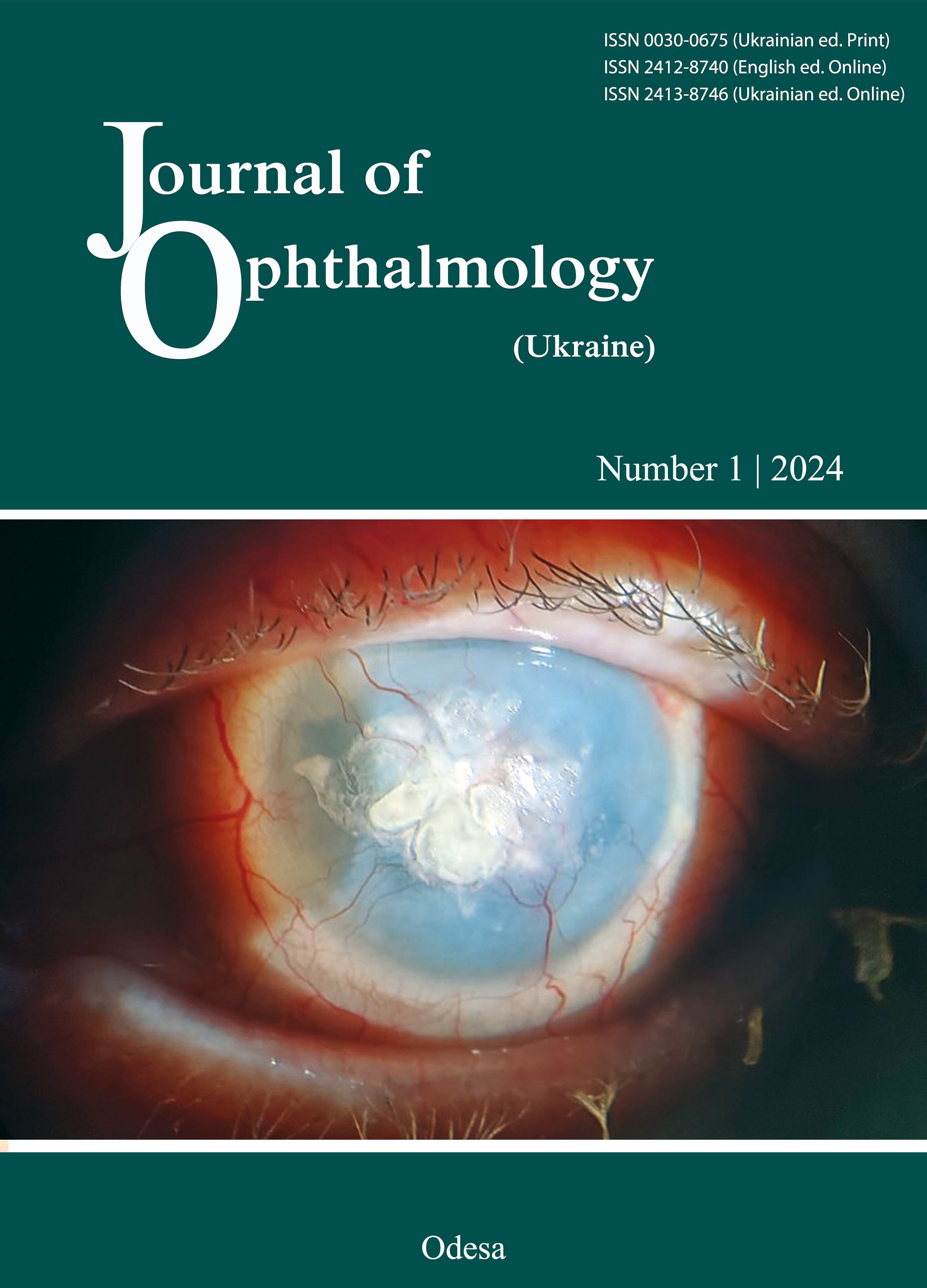Association of TLR4 rs1927911 polymorphism with diabetic retinopathy and diabetic macular edema in type 2 diabetic patients
DOI:
https://doi.org/10.31288/oftalmolzh202412026Keywords:
hyperglycemia, adaptive optics, retinal volume, regression analysisAbstract
Background: Genetic susceptibility is a factor in the development of ophthalmic complications in type 2 diabetes mellitus (T2DM). There are differences between polymorphisms of toll-like receptor-4 (TLR4) in terms of their association with microvascular complications of T2DM.
Purpose: To assess the association of TLR4 rs1927911 polymorphism with diabetic retinopathy (DR) and diabetic macular edema (DME) in T2DM.
Material and Methods: This study involved 81 type 2 diabetics (81 eyes) with both DR and DME and 50 type 2 diabetic controls (50 eyes) having normalized carbohydrate metabolism and neither DR nor DME. TLR4 rs1927911 genotypes were investigated by real time polymerase chain reaction (PCR) using Gene Amp® 7500 PCR System (Applied Biosystems, Foster City, CA) and TaqMan Mutation Detection Assays (Life Technologies, Carlsbad, CA).
Results: TLR4 rs1927911 polymorphism was associated with DR and DME (р = 0.021), and the risk of these complications was lower (OR = 0.42; 95% CI, 0.23–0.77) in allele A carriers than in ancestral allele G carriers. rs1927911 genotype distribution was significant by Pearson chi-square test under a dominant model (GG versus GA+AA; χ2 = 6.38; р = 0.012; OR = 0.37; 95% CI, 0.18-0.76). After patients were stratified by the stage of DR and the severity of DME, significant differences with regard to genotypes were observed only in proliferative DR and severe DME. Carriers of the heterozygous genotype and minor genotype AA showed less severe glycemia, lower HbA1c, and smaller central retinal thickness and total retinal volume than carriers of the ancestral genotype GG; this corresponded to less severe carbohydrate metabolism abnormalities and less severe retinal damage.
Conclusion: Pro-inflammatory pathways involve TLR4 under hyperglycemic conditions. Given the role of TLR4 in the mechanisms triggering the immune response, it may be supposed that the activity of these pathways is reduced in carriers of rs1927911 polymorphism, and it is this that causes reduced diabetic retinal damage.
References
Teo ZL, Tham YC, Yu M, Chee ML, Rim TH, Cheung N, et al. Global Prevalence of Diabetic Retinopathy and Projection of Burden through 2045: Systematic Review and Meta-analysis. Ophthalmology. 2021 Nov;128(11):1580-1591. https://doi.org/10.1016/j.ophtha.2021.04.027
Ixcamey M, Palma C. Diabetic macular edema. Dis Mon. 2021 May;67(5):101138. https://doi.org/10.1016/j.disamonth.2021.101138
Rykov S, Chugayev D. Diabetic macular edema in diabetic retinopathy and type 2 diabetes mellitus and content of L-selectin in the blood. Ophthalmology. Archive of Ukrainian Ophthalmology. 2023;11(1):24-29. doi: 110.22141/2309-8147.11.1.2023.313
Wong TY, Cheung CM, Larsen M, Sharma S, Simó R. Diabetic retinopathy. Nat Rev Dis Primers. 2016 Mar 17;2:16012. https://doi.org/10.1038/nrdp.2016.12
Bayan N, Yazdanpanah N, Rezaei N. Role of toll-like receptor 4 in diabetic retinopathy. Pharmacol Res. 2022 Jan;175:105960. Epub 2021 Oct 28. PMID: 34718133. https://doi.org/10.1016/j.phrs.2021.105960
Aghamiri SH, Komlakh K, Ghaffari M. The crosstalk among TLR2, TLR4 and pathogenic pathways; a treasure trove for treatment of diabetic neuropathy. Inflammopharmacology. 2022 Feb;30(1):51-60. https://doi.org/10.1007/s10787-021-00919-3
Steinle JJ. Role of HMGB1 signaling in the inflammatory process in diabetic retinopathy. Cell Signal. 2020 Sep;73:109687. https://doi.org/10.1016/j.cellsig.2020.109687
Nebbioso M, Lambiase A, Armentano M, Tucciarone G, Bonfiglio V, Plateroti R, Alisi L. The Complex Relationship between Diabetic Retinopathy and High-Mobility Group Box: A Review of Molecular Pathways and Therapeutic Strategies. Antioxidants (Basel). 2020 Jul 26;9(8):666. https://doi.org/10.3390/antiox9080666
Wang Y, Tao J, Jiang M, Yao Y. Apocynin ameliorates diabetic retinopathy in rats: Involvement of TLR4/NF-κB signaling pathway. Int Immunopharmacol. 2019 Aug;73:49-56. https://doi.org/10.1016/j.intimp.2019.04.062
Fang M, Wan W, Li Q, Wan W, Long Y, Liu H, Yang X. Asiatic acid attenuates diabetic retinopathy through TLR4/MyD88/NF-κB p65 mediated modulation of microglia polarization. Life Sci. 2021 Jul 15;277:119567. https://doi.org/10.1016/j.lfs.2021.119567
Shu X, Hu Y, Huang C, Wei N. Nimbolide ameliorates the streptozotocin-induced diabetic retinopathy in rats through the inhibition of TLR4/NF-κB signaling pathway. Saudi J Biol Sci. 2021 Aug;28(8):4255-4262. https://doi.org/10.1016/j.sjbs.2021.06.039
Gu C, Lhamo T, Zou C, Zhou C, Su T, Draga D, et al. Comprehensive analysis of angiogenesis-related genes and pathways in early diabetic retinopathy. BMC Med Genomics. 2020 Sep 29;13(1):142. https://doi.org/10.1186/s12920-020-00799-6
Wong YH, Wong SH, Wong XT, Yap QY, Yip KY, Wong LZ, et al. Genetic associated complications of type 2 diabetes mellitus. Panminerva Med. 2022 Jun;64(2):274-288. https://doi.org/10.23736/S0031-0808.21.04285-3
Rykov S, Ziablitsev S, Mogilevskyy S, Panchenko Iu, Biliaeva O, Lavryk N. The Role of Gene Polymorphisms rs1800629 TNFα and rs1800818 PDGFB in Relapses after Surgical Treatment of Diabetic Maculopathy. Ophthalmology. Eastern Europe. 2020;3(10):285-292. https://doi.org/10.34883/PI.2020.10.3.015
Zhang Y, Li H, Wang C, Lv H, Fu S. Toll like receptor 4 gene Asp299Gly polymorphism increases the risk of diabetic microvascular complications: a meta analysis. Diabetol Metab Syndr. 2022 Jun 7;14(1):79. https://doi.org/10.1186/s13098-022-00849-2
Buraczynska M, Zukowski P, Ksiazek K, Wacinski P, Dragan M. The effect of Toll-like receptor 4 gene polymorphism on vascular complications in type 2 diabetes patients. Diabetes Res Clin Pract. 2016 Jun;116:7-13. https://doi.org/10.1016/j.diabres.2016.04.002
Manolakis AC, Kapsoritakis AN, Tiaka EK, Sidiropoulos A, Gerovassili A, Satra M, et al. TLR4 gene polymorphisms: evidence for protection against type 2 diabetes but not for diabetes-associated ischaemic heart disease. Eur J Endocrinol. 2011 Aug;165(2):261-7. https://doi.org/10.1530/EJE-11-0280
Early Treatment Diabetic Retinopathy Study Research Group. Grading diabetic retinopathy from stereoscopic color fundus photographs - an extension of the modified Airlie house classification: ETDRS report № 10. Ophthalmology. 2020 Apr;127(4S): 99-119. https://doi.org/10.1016/j.ophtha.2020.01.030
Gur'ianov VG, Liakh II, Parii VD, Korotkyi OV, Chalyi OV, Tsekhmister IV. [Analysis of the results of medical studies using EZR (R-statistics) software: Biostatistics training manual]. Kyiv: Vistka; 2018. Ukrainian.
Xu Y, Jiang Z, Huang J, Meng Q, Coh P, Tao L. The association between toll-like receptor 4 polymorphisms and diabetic retinopathy in Chinese patients with type 2 diabetes. Br J Ophthalmol. 2015 Sep;99(9):1301-5. Epub 2015 May 6. PMID: 25947554. https://doi.org/10.1136/bjophthalmol-2015-306677
Singh K, Kant S, Singh VK, Agrawal NK, Gupta SK, Singh K. Toll-like receptor 4 polymorphisms and their haplotypes modulate the risk of developing diabetic retinopathy in type 2 diabetes patients. Mol Vis. 2014 May 27;20:704-13. PMID: 24883015; PMCID: PMC4037533.
Seidel A, Liu L, Jiang Y, Steinle JJ. Loss of TLR4 in endothelial cells but not Müller cells protects the diabetic retina. Exp Eye Res. 2021 May;206:108557. https://doi.org/10.1016/j.exer.2021.108557
Fu H, Liu H. Deletion of toll-like receptor 4 ameliorates diabetic retinopathy in mice. Arch Physiol Biochem. 2023 Apr;129(2):519-525. https://doi.org/10.1080/13813455.2020.1841795
Wang L, Wang J, Fang J, Zhou H, Liu X, Su SB. High glucose induces and activates Toll-like receptor 4 in endothelial cells of diabetic retinopathy. Diabetol Metab Syndr. 2015 Oct 13;7:89. https://doi.org/10.1186/s13098-015-0086-4
Hu L, Yang H, Ai M, Jiang S. Inhibition of TLR4 alleviates the inflammation and apoptosis of retinal ganglion cells in high glucose. Graefes Arch Clin Exp Ophthalmol. 2017 Nov;255(11):2199-2210. https://doi.org/10.1007/s00417-017-3772-0
Downloads
Published
How to Cite
Issue
Section
License
Copyright (c) 2024 Rykov S. O., Galytska Ie. P., Zhmuryk D. V., Dufynets V. A.

This work is licensed under a Creative Commons Attribution 4.0 International License.
This work is licensed under a Creative Commons Attribution 4.0 International (CC BY 4.0) that allows users to read, download, copy, distribute, print, search, or link to the full texts of the articles, or use them for any other lawful purpose, without asking prior permission from the publisher or the author as long as they cite the source.
COPYRIGHT NOTICE
Authors who publish in this journal agree to the following terms:
- Authors hold copyright immediately after publication of their works and retain publishing rights without any restrictions.
- The copyright commencement date complies the publication date of the issue, where the article is included in.
DEPOSIT POLICY
- Authors are permitted and encouraged to post their work online (e.g., in institutional repositories or on their website) during the editorial process, as it can lead to productive exchanges, as well as earlier and greater citation of published work.
- Authors are able to enter into separate, additional contractual arrangements for the non-exclusive distribution of the journal's published version of the work with an acknowledgement of its initial publication in this journal.
- Post-print (post-refereeing manuscript version) and publisher's PDF-version self-archiving is allowed.
- Archiving the pre-print (pre-refereeing manuscript version) not allowed.












